Helen F
Warrington
|
1 of 46
Tue 12th Jan 2016 11:27pm
Some of you will come across references to bits of St Mary's Priory that survived the demolition, and were visible before modern excavations. One of the buildings referred was called the Parliament House but there didn't seem to be any discussion as to it's actual location.
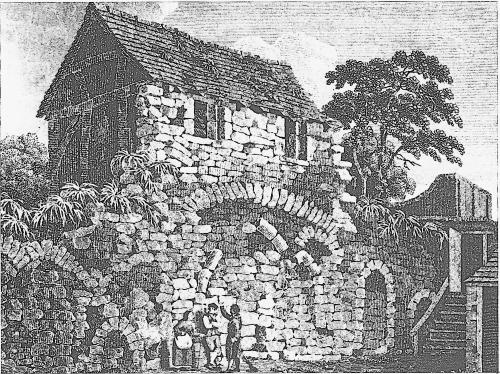
I'm 95% sure that this image shows the same view in 1910.
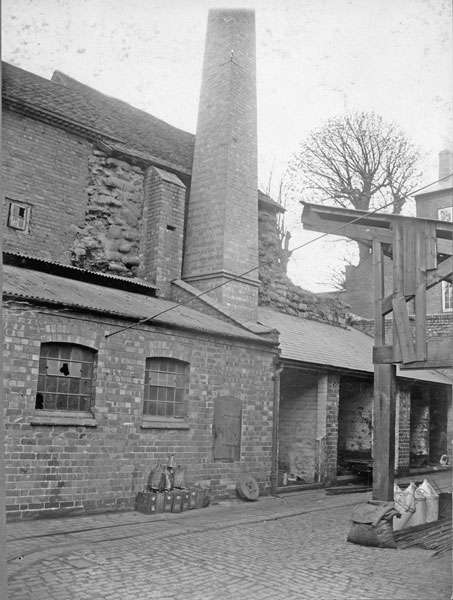
And here's part of a David Gee painting to put it into perspective. In 1849 the building in the 1910 photo was two storey.
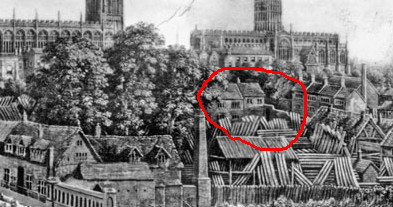
The steps up to the doorway led onto Hill Top. In an earlier image by William Henry Brook the brick building in the foreground wasn't there but there was a second brick building to the left of the Parliament House, built on the ruins, just like the one in the photo. It wouldn't have been visible in 1849 from the painter's eye but it would have been there.
The tree to the right and the curved bit of wall (you can just about see in all three pictures, was the rear of the garden that ran along side Hill Top. The red line on the map below shows the line of view.
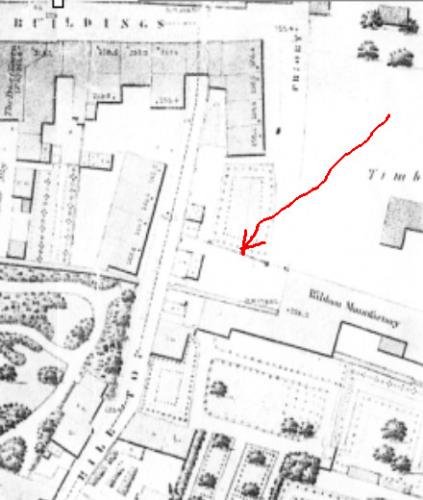 |
|
Local History and Heritage -
St Mary's Priory ruins and Hill Top
|
Annewiggy
Tamworth
|
2 of 46
Wed 13th Jan 2016 11:19am
Helen. I have a copy of "Coventry it's history & antiquities" by Benjamin Poole. He gives quite a long description of that area in 1869. I copied it out some time ago, in fact when they were doing Time Team so if you don't have a copy I can easily email it to you.
Not mentioned in the article but during the Wars of the Roses Parliament was held in Coventry in the Chapter House of St Mary's Priory from 1459.
|
|
Local History and Heritage -
St Mary's Priory ruins and Hill Top
|
Helen F
Warrington
Thread starter
|
3 of 46
Wed 13th Jan 2016 12:12pm
Hi Anne, that would be great. I've tried to place some of the drawings of the remains but only a few are identifiable and many no longer exist.
The building in the pictures is called the Parliament House but as you say, the War of the Roses Parliament was in the Chapter house that is supposed to be on the other side of Hill Top but a bit further south. Looking at the diagrams of the Priory, this was probably part of the infirmary. The whole upper half could be a rebuild using demolition stone but the arches below are part of the under croft. Originally I though some of the arches were reclaimed stone but there are similar groups of arches (eg Chester) The arches were filled in by the time the sketch was made but I have a copy one paining that suggests it was still a vaulted area, even after they'd built the house on top.
Chester gateway,

|
|
Local History and Heritage -
St Mary's Priory ruins and Hill Top
|
Helen F
Warrington
Thread starter
|
4 of 46
Fri 11th Nov 2016 12:41am
On 4th Nov 2016 2:53pm, Osmiroid said:
On 30th Apr 2016 7:13am, Helen F said:
Ha, I'd forgotten that one Dutchman  This older image is from almost the same spot but looking towards New Buildings and the spires.
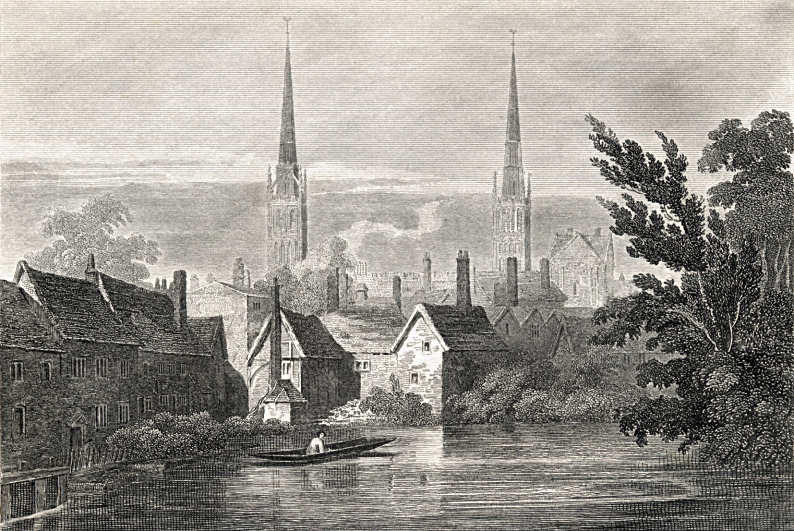
Have any of the buildings been identified? If I am reading it correctly the light building to the right of the church would be something on Butcher Row? And the foreground interestingly pre the demolition for Trinity St.
I know what most of them are. What you're looking at is the north end of the street called New Buildings, and looking south past it. A deceptive name because both that and New Street were erected just before the Civil War after some of the houses outside the wall were demolished to form a clear area so that the buildings weren't used as cover for enemy gunmen. On the left is the Priory mill and in front is the pond formed by the Sherbourne and the Radford Brook. The buildings curve round to just beyond that taller building with the flatter roof, where New Buildings goes off to the left and right and turns into Ironmongers. The tall building between Holy Trinity and the trees is the north tower of St Mary's before it was converted into the current form of the Blue Coat School. |
|
Local History and Heritage -
St Mary's Priory ruins and Hill Top
|
Osmiroid
UK
|
5 of 46
Fri 11th Nov 2016 1:28am
Brilliant info Helen, thanks  |
|
Local History and Heritage -
St Mary's Priory ruins and Hill Top
|
Helen F
Warrington
Thread starter
|
6 of 46
Fri 11th Nov 2016 11:21am
It's a pleasure to be able to pass on what others have shared.
Incidentally, in and before Henry VIII's time the scene would have been very different. It would have been dominated by St Mary's, stretching from the towers on the right and then well off to the left. The towers would have been about twice the current height with steeple on top, shorter than Holy Trinity because the design wouldn't have supported something as impressive. The central tower would be just left of St Michael's I think and would also have been shortish. I'm not sure how much of the two churches' towers would have been visible over the main body of St Mary's. Between the viewpoint and the cathedral would have been the cloister and in front of that the kitchen and a few minor buildings.
The mill would have been there on the left. By the time the drawing was made it was probably a saw mill and may have been one back to at least the 1600s, although a lot of the water redirection was as old as the priory. The view to the right of the scene would have been largely uninterrupted until you got to the bottom of Palmer lane and to the right of that, Bishop Street and the grammar school. Behind and to the left was the Hales Street Gate, then known as the Priory Gate. The road was called Priory Lane at that point and (having now checked) had that name in 1750. While a few genuinely new buildings were slotted in between and behind the civil war era buildings as can be seen in the drawing, the bulk of the building done on the street was well off to the left, beyond Hill Top, where factory buildings were erected over the remains of the priory and its out buildings and stretched off to the more modern Priory Lane. There was a funny collection of very old buildings at the bridge that also included a saw mill but I'm not sure that was its original purpose. Beyond that there was Miller Lane and by the name of the road one assumes what was originally a flour mill. Beyond that there was the Earl's Mill at the end of Cox Street (formerly Earl's Mill Lane) and this was also a flour mill.
To the left of the scene is Pool Meadow and that was what you'd have seen till at least 1750 although the land was slowly drying. The original pools were part of the Priory and used as fish farms. The mill pond in the scene had gone by 1850 and later became the Hales Street market area. It was the point where large sections of the rivers started to be built over.
Post copied from topic Hales Street on 31st Mar 2017 6:29 pm
|
|
Local History and Heritage -
St Mary's Priory ruins and Hill Top
|
Prof
Gloucester
|
7 of 46
Fri 31st Mar 2017 5:59pm
Re St Mary's Priory Helen F: would you agree that in essence it must have resembled Lichfield Cathedral (on a similar plan) though hemmed in by buildings might not have looked so impressive from the West end, the pier bases of which still remain in Priory Row and in the near top of New Buildings. This is how I always have imagined it. There are artists' impressions of the Priory but to me they look rather squat when compared with Lichfield.
|
|
Local History and Heritage -
St Mary's Priory ruins and Hill Top
|
Helen F
Warrington
Thread starter
|
8 of 46
Fri 31st Mar 2017 8:43pm
It's easy to forget that all the other cathedrals kept changing after St Mary's was demolished. Tall spires were a later addition to churches and St Mary's wasn't built for them. It still had its early Norman appearance. Had it survived, who knows what would have happened to it. The estimates of tower size are based on the excavated pillars and the assumptions that they couldn't have supported anything very tall. Images that survive (including a tapestry) show them a bit dumpy and angular. You can see them behind Holy Trinity and St Michaels.
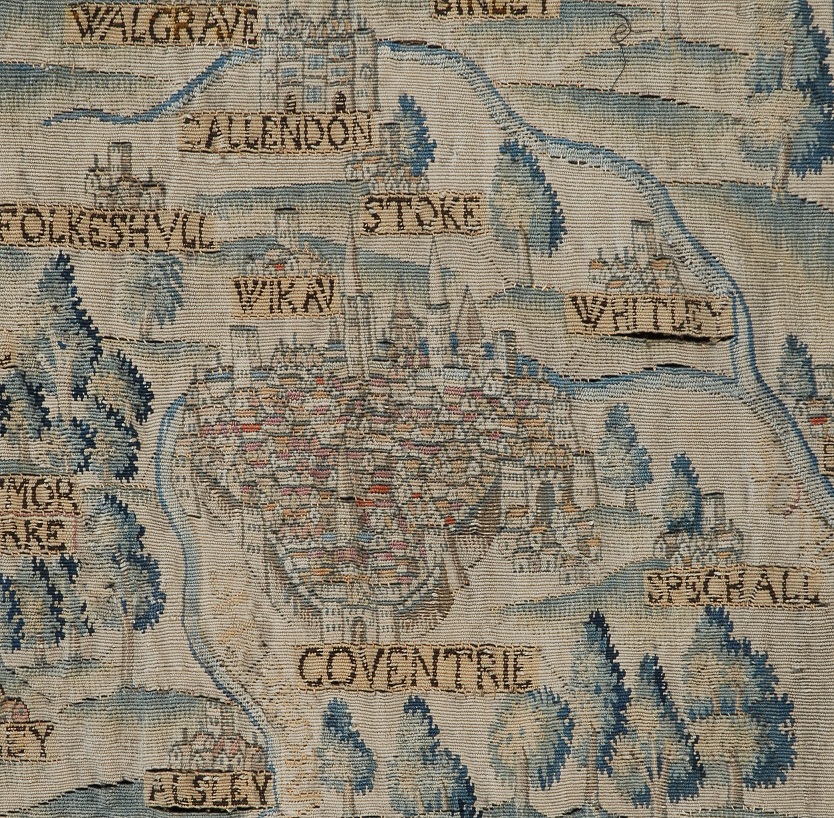
The front of the cathedral was originally just surrounded by a wall with a gate. It must have been carved heavily into the slope to give it a flat area. The retaining wall went to form the cellars of the Lych Gate Cottages. It's hard to tell whether those buildings had appeared before the time the monastery was dissolved. I've heard different accounts. It seems to be an open question since some timbers were tested. Were they reused or in situ? There was a building incongruously attached to the front left of the main door, called the Sextry. It looked totally out of place but I think it's the building where they stored the rich clothes and treasures of the Cathedral. Maybe it was a rebuild on the foundations? The buildings along the front wall, including the old half of the Spotted Dog were probably post Dissolution but there may have been lean too stalls against the wall and carts with things for sale.
As for the lack of view, I'm not sure that it's all that unusual. Probably the buildings that surrounded other cathedrals have been demolished in later years. For instance I know that St Michael's had houses/shops at the west end and along the area opposite Draper's Hall. One suggested reason for the funny kink in the line of the church was because it had to respect those existing buildings.
The Bull Ring and all those butcher's shops are an odd thing to have outside the gates but priories were essentially money making ventures. They might have wanted the butchers elsewhere but they controlled the market and taxes, so they would have needed to keep an eye on trade. I assume the Bull Ring predated Henry VIII. Elizabeth certainly watched bulls being bated there. Perhaps the monks liked a bit of animal cruelty too?
Another thing we are familiar with is the decoration on existing churches. I'm not sure how like the original they are. It probably varies depending upon what they were built with. St Michael's and probably St Mary's were built from Coventry stone, which is quite soft. Bits were always dropping off or needing to be repaired just because they'd dissolved. St Michaels had a full refurbish in the Victorian era and all the exterior statues were replaced. Of the sketches I've seen the new ones don't look very like the originals and even those didn't look medieval to me.
It's a hodge podge of an answer. I haven't really spent much time absorbing information about St Mary's but there is a good book about it with pictures of a digital reconstruction in it. |
|
Local History and Heritage -
St Mary's Priory ruins and Hill Top
|
Prof
Gloucester
|
9 of 46
Sat 8th Apr 2017 8:31pm
What a mine of information Helen F! I am quite amazed by the tapestry. Does it still exist and if so where? I take the point about the squat towers of St Mary's, so after all it was not as impressive as Lichfield, though had it been so it might have dwarfed Holy Trinity and St Michael's churches which are fine specimens of medieval architecture. Regarding the kink in the line of St Michael's, some churches were designed with a kink in the choir to symbolise how Christ hung on the Cross, or so I read somewhere.
|
|
Local History and Heritage -
St Mary's Priory ruins and Hill Top
|
Helen F
Warrington
Thread starter
|
10 of 46
Sat 8th Apr 2017 11:06pm
Sheldon Tapestry Map
The tapestry is at the Warwick Market Hall Museum but I haven't investigated how accessible it is.
My knowledge is from snippets I've picked up while looking for details about the appearance of the city, so it's not complete or chronological. You could well be right about the kink, I've just been to Suffolk and at least one of the churches was wonky too but the piecemeal way the church was built must have made the different phases hard to keep aligned.
|
|
Local History and Heritage -
St Mary's Priory ruins and Hill Top
|
Annewiggy
Tamworth
|
11 of 46
Sun 9th Apr 2017 11:00am
The web site says the Market Hall Museum was refurbished in February. It is open Tuesday to Saturdays, it says it's open Sundays in April but does not appear to be open today. It is FREE. It also says it is level access on the ground floor and a lift to the first floor although the old floors are uneven. Hope this helps.
Warwick Market Hall Museum
My daughters friend works there so she is going to find out if the tapestry is still in the museum. |
|
Local History and Heritage -
St Mary's Priory ruins and Hill Top
|
Helen F
Warrington
Thread starter
|
12 of 46
Sun 14th Jan 2018 10:25am
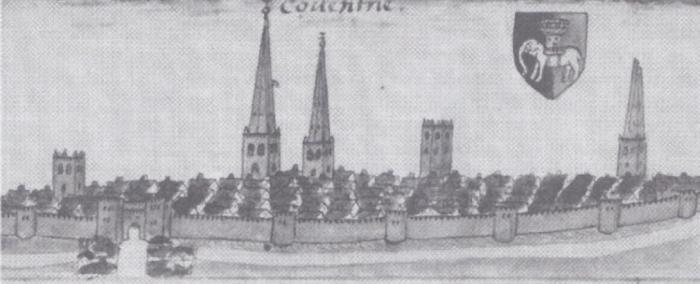
The picture above is officially the earliest known view of Coventry by William Smyth in 1576 (give or take the Tapestry). It's variously argued that the view is from the north east with a bigger Cook Street gate in the foreground and the partially demolished Whitefriars church on the far left. The remains of St Mary's would be the western towers and Greyfriars would be on the far right. St John's would be off the picture. Alternatively the picture could be from the east south east with St John's on the left and Greyfriars on the far right and the drawing would be slightly dodgy because it was from memory and the towers of St Michaels and Holy Trinity were mixed up. In that theory the ruined tower of St Mary's shown would be the central crossing tower.
I put forward another theory. Everyone assumed that the tallest tower in the sketch is St Michael's but I think that it might be Greyfriars from the south south east and the gate is Greyfriars gate. The tower is the biggest simply because it was closest. That makes the left hand tower St John's. Then to the right of Greyfriars it would be Holy Trinity and on the far right a rather weedy St Michael's. That does makes the ruined St Mary's tower the central crossing and not the west end towers.
I've recently held the idea that the central tower was octagonal and the shading on the Smyth sketch would support the idea. St Mary's was all about octagons for some reason. In fact with the Spon Street gate, the Coventry Cross and even Greyfriars and St Michaels spire, octagons were popular in Coventry full stop. An octagonal tower might have been supported differently to a square tower and explain how it could have been taller than the normal supports suggest and carry a spire, albeit a wooden one.
My theory for the Smyth image is partly based on the following painting. Plus, the multiple small towers along the wall fits the theory the images is from the south and Greyfriars gate was one of the few with buildings outside the gate (as show in Smyth's picture). Possible?
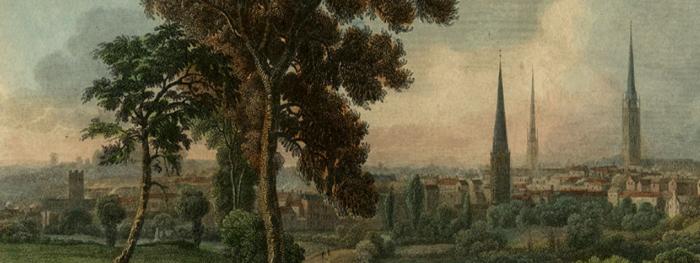
|
|
Local History and Heritage -
St Mary's Priory ruins and Hill Top
|
Rob Orland
Historic Coventry
|
13 of 46
Sun 14th Jan 2018 10:42am
That's fabulous Helen, and yes, anything could be possible, especially if, as you suggest, the original drawing was made from memory. I guess if I was to visit a town and then make a sketch later, I'd probably recall the salient points - but not necessarily in the right order, as Eric Morecambe would've said!
|
|
Local History and Heritage -
St Mary's Priory ruins and Hill Top
|
Annewiggy
Tamworth
|
14 of 46
Sun 14th Jan 2018 11:59am
This is a 1732 view from the south which seems to agree with your theory Helen (sorry about the quality, difficult to take a framed picture). Greyfriars Gate can just be seen where the coach is heading for and showing trees outside as on the 1500's picture. St John's on the left although it is called Bablake Church on this and the spires from the left marked as Greyfriars, Holy Trinity and St Michael's. Coventry Cross can just be seen to the right of Greyfriars.

|
|
Local History and Heritage -
St Mary's Priory ruins and Hill Top
|
NeilsYard
Coventry
|
15 of 46
Sun 14th Jan 2018 1:21pm
Great stuff Helen/Anne  I've wondered before what the earliest 'image' of Coventry was. Do we have a definitive earliest known photograph? |
|
Local History and Heritage -
St Mary's Priory ruins and Hill Top
|
 I'm 95% sure that this image shows the same view in 1910.
I'm 95% sure that this image shows the same view in 1910.
 And here's part of a David Gee painting to put it into perspective. In 1849 the building in the 1910 photo was two storey.
And here's part of a David Gee painting to put it into perspective. In 1849 the building in the 1910 photo was two storey.
 The steps up to the doorway led onto Hill Top. In an earlier image by William Henry Brook the brick building in the foreground wasn't there but there was a second brick building to the left of the Parliament House, built on the ruins, just like the one in the photo. It wouldn't have been visible in 1849 from the painter's eye but it would have been there.
The tree to the right and the curved bit of wall (you can just about see in all three pictures, was the rear of the garden that ran along side Hill Top. The red line on the map below shows the line of view.
The steps up to the doorway led onto Hill Top. In an earlier image by William Henry Brook the brick building in the foreground wasn't there but there was a second brick building to the left of the Parliament House, built on the ruins, just like the one in the photo. It wouldn't have been visible in 1849 from the painter's eye but it would have been there.
The tree to the right and the curved bit of wall (you can just about see in all three pictures, was the rear of the garden that ran along side Hill Top. The red line on the map below shows the line of view.





![Next page [or press the "Right arrow" key] Next page](../resource/colour_tint_inc.php?img_file=right-arrow.png&clr=AA5511)
![Last page [or press the "L" key] Last page](../resource/colour_tint_inc.php?img_file=right-arrow-end.png&clr=AA5511)


 The front of the cathedral was originally just surrounded by a wall with a gate. It must have been carved heavily into the slope to give it a flat area. The retaining wall went to form the cellars of the Lych Gate Cottages. It's hard to tell whether those buildings had appeared before the time the monastery was dissolved. I've heard different accounts. It seems to be an open question since some timbers were tested. Were they reused or in situ? There was a building incongruously attached to the front left of the main door, called the Sextry. It looked totally out of place but I think it's the building where they stored the rich clothes and treasures of the Cathedral. Maybe it was a rebuild on the foundations? The buildings along the front wall, including the old half of the Spotted Dog were probably post Dissolution but there may have been lean too stalls against the wall and carts with things for sale.
As for the lack of view, I'm not sure that it's all that unusual. Probably the buildings that surrounded other cathedrals have been demolished in later years. For instance I know that St Michael's had houses/shops at the west end and along the area opposite Draper's Hall. One suggested reason for the funny kink in the line of the church was because it had to respect those existing buildings.
The Bull Ring and all those butcher's shops are an odd thing to have outside the gates but priories were essentially money making ventures. They might have wanted the butchers elsewhere but they controlled the market and taxes, so they would have needed to keep an eye on trade. I assume the Bull Ring predated Henry VIII. Elizabeth certainly watched bulls being bated there. Perhaps the monks liked a bit of animal cruelty too?
Another thing we are familiar with is the decoration on existing churches. I'm not sure how like the original they are. It probably varies depending upon what they were built with. St Michael's and probably St Mary's were built from Coventry stone, which is quite soft. Bits were always dropping off or needing to be repaired just because they'd dissolved. St Michaels had a full refurbish in the Victorian era and all the exterior statues were replaced. Of the sketches I've seen the new ones don't look very like the originals and even those didn't look medieval to me.
It's a hodge podge of an answer. I haven't really spent much time absorbing information about St Mary's but there is a good book about it with pictures of a digital reconstruction in it.
The front of the cathedral was originally just surrounded by a wall with a gate. It must have been carved heavily into the slope to give it a flat area. The retaining wall went to form the cellars of the Lych Gate Cottages. It's hard to tell whether those buildings had appeared before the time the monastery was dissolved. I've heard different accounts. It seems to be an open question since some timbers were tested. Were they reused or in situ? There was a building incongruously attached to the front left of the main door, called the Sextry. It looked totally out of place but I think it's the building where they stored the rich clothes and treasures of the Cathedral. Maybe it was a rebuild on the foundations? The buildings along the front wall, including the old half of the Spotted Dog were probably post Dissolution but there may have been lean too stalls against the wall and carts with things for sale.
As for the lack of view, I'm not sure that it's all that unusual. Probably the buildings that surrounded other cathedrals have been demolished in later years. For instance I know that St Michael's had houses/shops at the west end and along the area opposite Draper's Hall. One suggested reason for the funny kink in the line of the church was because it had to respect those existing buildings.
The Bull Ring and all those butcher's shops are an odd thing to have outside the gates but priories were essentially money making ventures. They might have wanted the butchers elsewhere but they controlled the market and taxes, so they would have needed to keep an eye on trade. I assume the Bull Ring predated Henry VIII. Elizabeth certainly watched bulls being bated there. Perhaps the monks liked a bit of animal cruelty too?
Another thing we are familiar with is the decoration on existing churches. I'm not sure how like the original they are. It probably varies depending upon what they were built with. St Michael's and probably St Mary's were built from Coventry stone, which is quite soft. Bits were always dropping off or needing to be repaired just because they'd dissolved. St Michaels had a full refurbish in the Victorian era and all the exterior statues were replaced. Of the sketches I've seen the new ones don't look very like the originals and even those didn't look medieval to me.
It's a hodge podge of an answer. I haven't really spent much time absorbing information about St Mary's but there is a good book about it with pictures of a digital reconstruction in it. The picture above is officially the earliest known view of Coventry by William Smyth in 1576 (give or take the Tapestry). It's variously argued that the view is from the north east with a bigger Cook Street gate in the foreground and the partially demolished Whitefriars church on the far left. The remains of St Mary's would be the western towers and Greyfriars would be on the far right. St John's would be off the picture. Alternatively the picture could be from the east south east with St John's on the left and Greyfriars on the far right and the drawing would be slightly dodgy because it was from memory and the towers of St Michaels and Holy Trinity were mixed up. In that theory the ruined tower of St Mary's shown would be the central crossing tower.
I put forward another theory. Everyone assumed that the tallest tower in the sketch is St Michael's but I think that it might be Greyfriars from the south south east and the gate is Greyfriars gate. The tower is the biggest simply because it was closest. That makes the left hand tower St John's. Then to the right of Greyfriars it would be Holy Trinity and on the far right a rather weedy St Michael's. That does makes the ruined St Mary's tower the central crossing and not the west end towers.
I've recently held the idea that the central tower was octagonal and the shading on the Smyth sketch would support the idea. St Mary's was all about octagons for some reason. In fact with the Spon Street gate, the Coventry Cross and even Greyfriars and St Michaels spire, octagons were popular in Coventry full stop. An octagonal tower might have been supported differently to a square tower and explain how it could have been taller than the normal supports suggest and carry a spire, albeit a wooden one.
My theory for the Smyth image is partly based on the following painting. Plus, the multiple small towers along the wall fits the theory the images is from the south and Greyfriars gate was one of the few with buildings outside the gate (as show in Smyth's picture). Possible?
The picture above is officially the earliest known view of Coventry by William Smyth in 1576 (give or take the Tapestry). It's variously argued that the view is from the north east with a bigger Cook Street gate in the foreground and the partially demolished Whitefriars church on the far left. The remains of St Mary's would be the western towers and Greyfriars would be on the far right. St John's would be off the picture. Alternatively the picture could be from the east south east with St John's on the left and Greyfriars on the far right and the drawing would be slightly dodgy because it was from memory and the towers of St Michaels and Holy Trinity were mixed up. In that theory the ruined tower of St Mary's shown would be the central crossing tower.
I put forward another theory. Everyone assumed that the tallest tower in the sketch is St Michael's but I think that it might be Greyfriars from the south south east and the gate is Greyfriars gate. The tower is the biggest simply because it was closest. That makes the left hand tower St John's. Then to the right of Greyfriars it would be Holy Trinity and on the far right a rather weedy St Michael's. That does makes the ruined St Mary's tower the central crossing and not the west end towers.
I've recently held the idea that the central tower was octagonal and the shading on the Smyth sketch would support the idea. St Mary's was all about octagons for some reason. In fact with the Spon Street gate, the Coventry Cross and even Greyfriars and St Michaels spire, octagons were popular in Coventry full stop. An octagonal tower might have been supported differently to a square tower and explain how it could have been taller than the normal supports suggest and carry a spire, albeit a wooden one.
My theory for the Smyth image is partly based on the following painting. Plus, the multiple small towers along the wall fits the theory the images is from the south and Greyfriars gate was one of the few with buildings outside the gate (as show in Smyth's picture). Possible?


